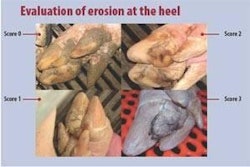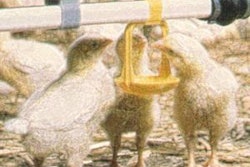The swine production sector is facing several challenges. The removal of antibiotic growth promoters (AGPs), for example, has put additional pressure on European swine producers. Hence, the implementation of sound hygienic farm conditions and elaborate feeding concepts are key to sustainability and profitability in modern swine production.
Growing concern about AGPs in animal nutrition has created efforts to use different alternative growth-promoting agents in swine nutrition. Among potential candidates, phytogenics represent a new and exciting group of feed additives, originating principally from herbs, spices or other plants. An improvement in feed conversion ratio has been observed in recent trials conducted in Europe and in the US. It is, however, not only their flavouring properties but also a number of biological activities that make phytogenics an encouraging approach in animal nutrition. Big improvements in feed conversion have been obtained in comparison with AGPs. As a result of ongoing research, phytogenics are seen as effective performance enhancers, especially in antibiotic-free feeding systems.
Phytogenics affect feed conversion
Optimising feed conversion ratio is crucial for efficiency in swine production. A trial was recently carried out at Kansas State University to evaluate the efficacy of phytogenics in comparison with AGPs in post-weaning piglets (Sulabo et al., 2007). In the trial, 192 piglets (22 days of age) were assigned to four treatment groups: Group 1 was fed a negative control diet without growth promoters. Both groups 2 and 3 (shown in Figures 1 and 2 as Phytogenics A and B) received the negative control diet supplemented with phytogenics. Group 4 was offered a positive control diet containing AGPs (140g/t neomycin sulfate and 140g/t oxytetracycline HCl). Growth performance was significantly improved when phytogenics or AGPs were added to the feed. In terms of average daily gains, the pigs fed phytogenics were intermediate between the negative control and the AGPs (Figure 1). Feed conversion, however, was best in the groups receiving phytogenics (Figure 2). The phytogenic feed additive under investigation in this instance, Biomin PEP, contained a defined blend of essential oils from anise, citrus and oregano and plant extracts. It can be concluded from this trial that well-selected phytogenics can be used to improve growth performance in post-weaning piglets, especially in antibiotic-free feeding regimens.
A trial in Denmark by Danske Slagterier also showed an increase in performance when the feed was supplemented with phytogenics. In this trial, 384 pigs (five weeks of age) were fed a negative control diet or the negative control diet with supplemental phytogenics. The feed was pelleted at a minimum temperature of 81C.
Daily gain and feed conversion ratio were improved by 5.2% and 4.5%, respectively, and Danish Production Value also rose 10.3% through supplementation of the feed with phytogenics. The Danish Production Value is an indicator of productivity and is calculated as: (kg gain × DKK/kg gain) (number of analysed FUp × DKK/FUp), with figures being based on average local prices. Similarly, a field trial in South Africa (Carletonville area, North West Province) recently showed the benefits of phytogenics in weaned pigs.
Pigs in group A (control) were fed a basal diet with Tylan (1kg/t) and zinc oxide (4kg/t), while pigs in group B were fed the basal diet supplemented with phytogenics. Daily weight gain saw major improvements when the pigs were fed phytogenics. Pigs in group B were also more uniform in size at the end of the trial.
Substitute for AGPs
As shown in the above trial data, phytogenics work well in diets with or without antibiotics and could even replace AGPs in feed formulations for swine. Meanwhile, the use of AGPs is also a subject of public criticism in North America and discussions about a ban of these substances following Europe's example has gained potential. The experience shows that the ban of AGPs does not leave an insuperable hurdle for swine producers. One reason is that management practices can still be optimised to improve hygienic conditions and to minimise the impact of environmental stressors. Furthermore, effective alternative feed additives are available.
Phytogenic feed additives are usually available in the form of dried and ground material, extracts or essential oils. They contain a large number of biological activities, therefore having the potential to boost gut health and performance. However, phytogenic feed additives vary in their chemical composition, resulting in large differences in efficacy between phytogenic products in the market.
A big challenge for swine producers is to find the suitable product formulation out of an increasing number of phytogenic feed additives which are available.
Many herbs and spices are known for their flavouring properties, thus having the potential to stimulate voluntary feed intake an effect often observed in lactating sows (Miller et al., 2003). In the production of piglets, weaning is a critical point, since the transition from sow's milk to solid feed is a challenge to the piglets' digestive system, which can easily cause diarrhoea coinciding with dramatic drops in performance. Well-selected phytogenics may stabilise gut health and support digestion during this critical period.
An extensive study at the University of Natural Resources and Applied Life Sciences, Vienna (Kroismayr et al., 2005), discovered significant effects caused by the phytogenic additive, with respect to gastrointestinal, and blood and immune parameters. These effects were also associated with improved growth performance.
Well-investigated phytogenics are an efficient tool to support animal health and growth performance. Since they do not pose any risk regarding antibiotic resistance or residues in animal products such as meat, eggs or milk, phytogenics are expected to gain high consumer acceptance and are regarded as safe alternatives to AGPs. Particular attention, however, has to be paid on the composition of formulations which are available in the market.
















